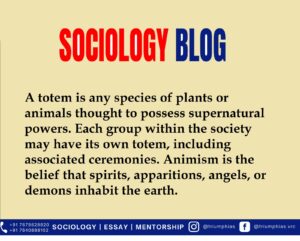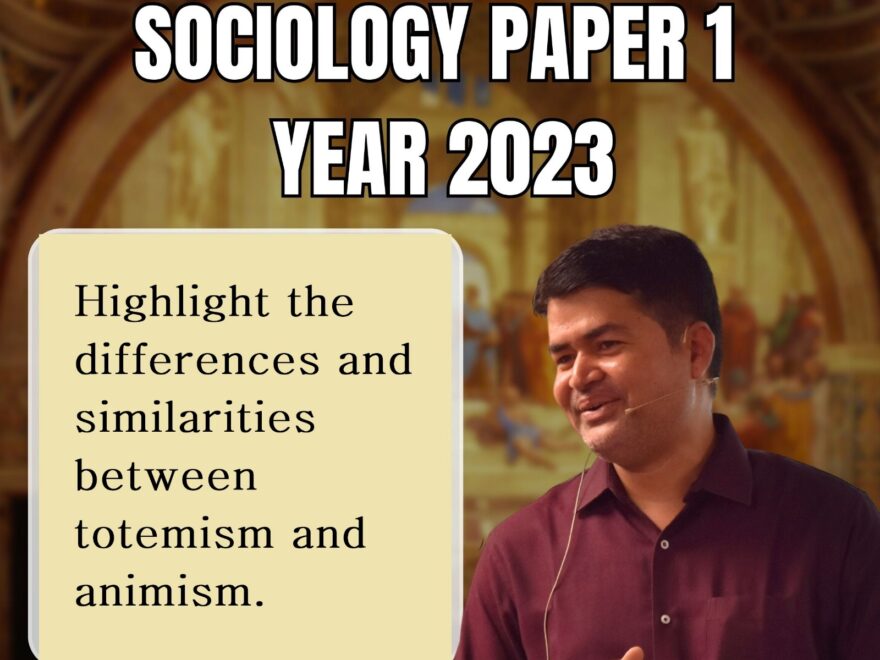Highlight the differences and similarities between totemism and animism.
Section: A.
Sociology Paper 2023 Analysis.
Relevant for Paper 1: Unit 8 Religious and Society; Types of Religious Practices

Question 4 (c): Highlight the differences and similarities between totemism and animism.
(10 Marks)
|
Introduction: Introduce the Basic Idea about Both Totemism and Animism. Main Body: Then Highlight the Similarities and Differences on the Lines of Belief, mode of Worship , Impact and Relation with Social Systems etc. Conclusion: On the Lines of Reflection of the Diverse and Complex Nature of Indigenous Belief Systems Around the World. |
Introduction:
Totemism and animism are two different belief systems that are often associated with indigenous cultures and the spiritual practices of various societies:
- Totemism is a religious practice centred on the worship of a particular animal, object, or symbol believed to possess supernatural powers or to be the embodiment of a particular group or clan’s ancestors.
For example : The Native American tribes of the Pacific Northwest, such as the Haida and Tlingit, practice totemism. They carve totem poles featuring animals and supernatural beings, which serve as emblems of clans or families and tell the stories of their ancestral spirits.
- Animism is the belief that objects, places, and creatures all possess a distinct spiritual essence. It is the world’s oldest religion, extending back to the earliest forms of human spirituality.
For example The Shinto religion in Japan is an example of animism. It involves the worship of kami, which are spirits believed to inhabit all things, including animals, plants, rocks, mountains, rivers, and even man-made objects.
Main body:
Similarities between Totemism and Animism:
- Spiritual Beliefs: Both totemism and animism are based on the belief in supernatural powers and spirits. They both attribute spiritual essence to non-human entities.
- Ancestor Worship: Both totemism and animism involve the worship of ancestors. In totemism, the totem is often believed to be an ancestor or to possess the spirit of an ancestor. In animism, ancestors are often believed to continue to exist in a spiritual form after death.
- Respect for Nature: Both totemism and animism involve a deep respect for nature. In totemism, the totem is often a natural entity, such as an animal or plant. In animism, all natural entities are believed to possess a spiritual essence.
- Rituals and Symbols: Both totemism and animism utilize rituals, symbols, and sacred objects in their practices. Totem animals and other natural symbols are commonly used in both belief systems.
Differences between Totemism and Animism:
- Scope: Animism is a broader concept than totemism. While totemism involves the worship of a specific totem, animism involves the belief that all objects, places, and creatures possess a spiritual essence.
- Community Aspect: Totemism has a strong community aspect, with the totem often serving as a symbol of a particular group or clan. Animism, on the other hand, does not necessarily involve a community aspect.
- Rituals: The rituals associated with totemism and animism can also differ. Totemism often involves rituals related to the totem, such as dances or ceremonies. Animism, on the other hand, may involve a wider range of rituals, depending on the specific beliefs of the animist.
- Distinctive Symbols v/s Fluid and Varied: Totemism often emphasizes unique and distinct symbols associated with specific groups, clans, or individuals. Animism is fluid and varied in its interpretations, with different cultures having their own unique practices and beliefs related to the spirits in the natural world.
Conclusion:
The differences and similarities between totemism and animism highlight the diverse and complex nature of indigenous belief systems worldwide. These spiritual traditions, while interconnected by their reverence for the supernatural and nature, exhibit unique features in terms of belief scope, community significance, rituals, and symbols, reflecting the rich tapestry of human spirituality and cultural diversity.
Related Blogs…
 |
 |

To master these intricacies and fare well in the Sociology Optional Syllabus, aspiring sociologists might benefit from guidance by the Best Sociology Optional Teacher and participation in the Best Sociology Optional Coaching. These avenues provide comprehensive assistance, ensuring a solid understanding of sociology’s diverse methodologies and techniques.
META TAGS:
Iron Law of Oligarchy, Robert Michels, Vilfredo Pareto, Lions and Foxes theory, power dynamics, organizational oligarchy, elite circulation, political sociology, leadership styles, organizational control, sociological theories, political maneuvering, elite differentiation, power concentration, societal stability, political leadership, strategic political leadership, Sociology Question Paper, Sociology Question Paper 2023, Sociology Question Paper CYQ, Sociology Question Paper UPSC, What, according to Robert Michels, is the iron law of oligarchy? Do lions and foxes in Vilfredo Pareto’s theory, essentially differ from each other? Substantiate.
Why Vikash Ranjan’s Classes for Sociology?
Proper guidance and assistance are required to learn the skill of interlinking current happenings with the conventional topics. VIKASH RANJAN SIR at TRIUMPH IAS guides students according to the Recent Trends of UPSC, making him the Best Sociology Teacher for Sociology Optional UPSC.
At Triumph IAS, the Best Sociology Optional Coaching platform, we not only provide the best study material and applied classes for Sociology for IAS but also conduct regular assignments and class tests to assess candidates’ writing skills and understanding of the subject.
Choose The Best Sociology Optional Teacher for IAS Preparation?
At the beginning of the journey for Civil Services Examination preparation, many students face a pivotal decision – selecting their optional subject. Questions such as “which optional subject is the best?” and “which optional subject is the most scoring?” frequently come to mind. Choosing the right optional subject, like choosing the best sociology optional teacher, is a subjective yet vital step that requires a thoughtful decision based on facts. A misstep in this crucial decision can indeed prove disastrous.
Ever since the exam pattern was revamped in 2013, the UPSC has eliminated the need for a second optional subject. Now, candidates have to choose only one optional subject for the UPSC Mains, which has two papers of 250 marks each. One of the compelling choices for many has been the sociology optional. However, it’s strongly advised to decide on your optional subject for mains well ahead of time to get sufficient time to complete the syllabus. After all, most students score similarly in General Studies Papers; it’s the score in the optional subject & essay that contributes significantly to the final selection.
“A sound strategy does not rely solely on the popular
Opinion of toppers or famous YouTubers cum teachers.”
It requires understanding one’s ability, interest, and the relevance of the subject, not just for the exam but also for life in general. Hence, when selecting the best sociology teacher, one must consider the usefulness of sociology optional coaching in General Studies, Essay, and Personality Test.
The choice of the optional subject should be based on objective criteria, such as the nature, scope, and size of the syllabus, uniformity and stability in the question pattern, relevance of the syllabic content in daily life in society, and the availability of study material and guidance. For example, choosing the best sociology optional coaching can ensure access to top-quality study materials and experienced teachers. Always remember, the approach of the UPSC optional subject differs from your academic studies of subjects. Therefore, before settling for sociology optional, you need to analyze the syllabus, previous years’ pattern, subject requirements (be it ideal, visionary, numerical, conceptual theoretical), and your comfort level with the subject.
This decision marks a critical point in your UPSC – CSE journey, potentially determining your success in a career in IAS/Civil Services. Therefore, it’s crucial to choose wisely, whether it’s the optional subject or the best sociology optional teacher. Always base your decision on accurate facts, and never let your emotional biases guide your choices. After all, the search for the best sociology optional coaching is about finding the perfect fit for your unique academic needs and aspirations.
Follow us :
🔎 https://www.instagram.com/triumphias
🔎 https://www.youtube.com/c/TriumphIAS
🔎 https://t.me/VikashRanjanSociology
Find More Blogs…
| Compare and contrast Karl Marx’s and Max weber’s | Karl Marx- Historical Materialism |
| Position of Women In the Modern Indian Society | Sociology: Social system and pattern variables |
KEYWORD: differences and similarities between totemism and animism, differences and similarities between totemism and animism, differences and similarities between totemism and animism, differences and similarities between totemism and animism, differences and similarities between totemism and animism, differences and similarities between totemism and animism, differences and similarities between totemism and animism, differences and similarities between totemism and animism, differences and similarities between totemism and animism, differences and similarities between totemism and animism, differences and similarities between totemism and animism, differences and similarities between totemism and animism



